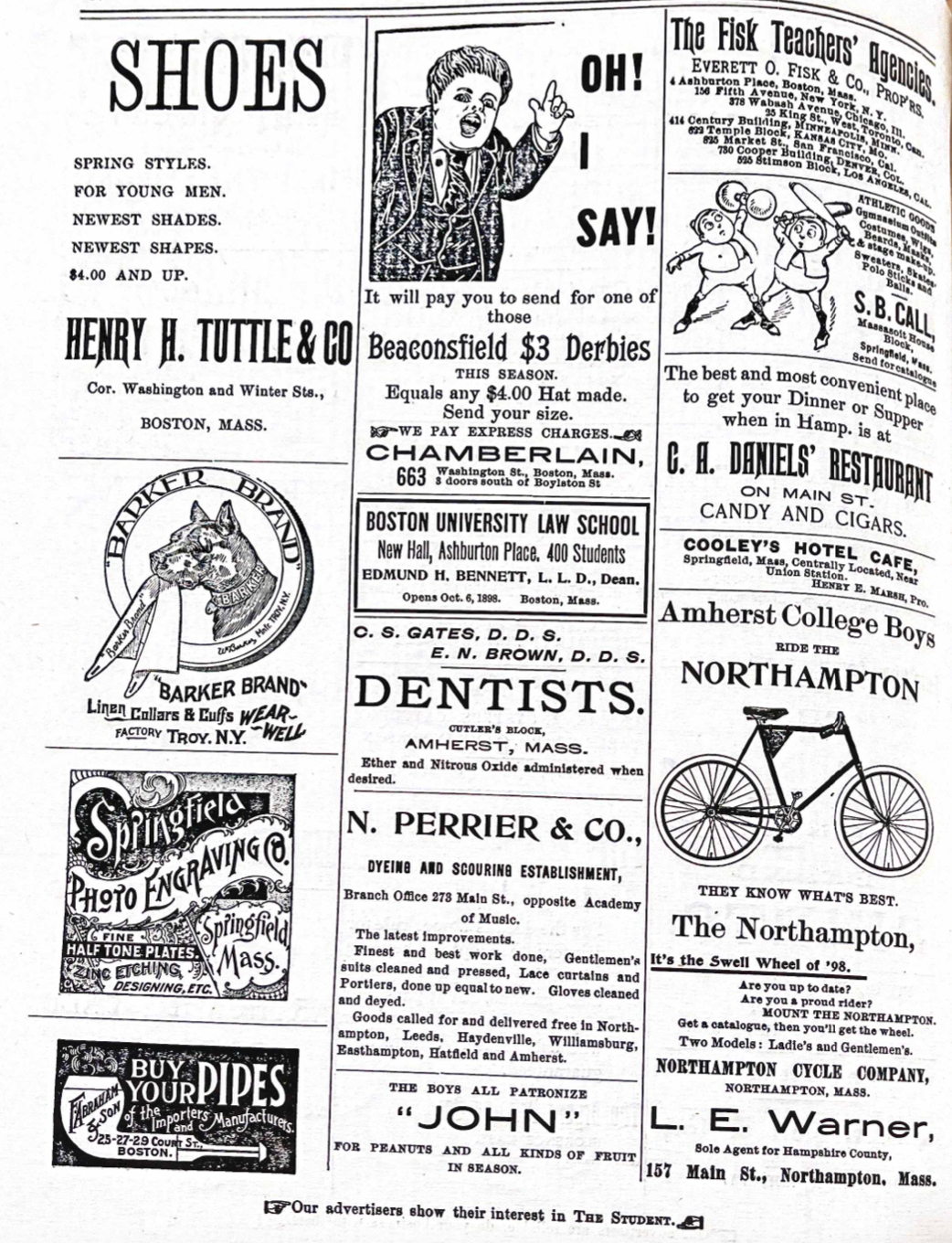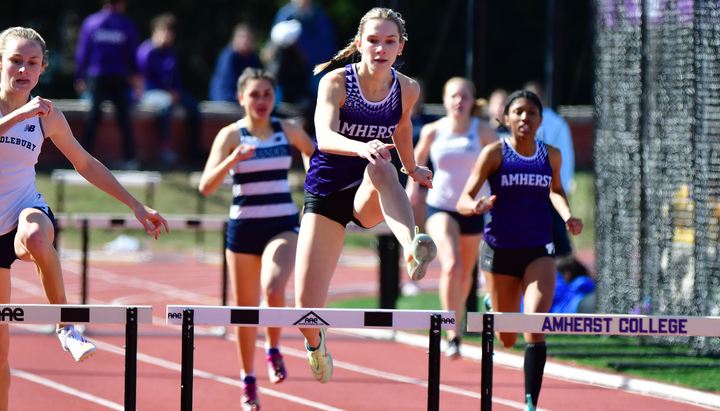Old News: This Week in 1898
Touring performances, alumni visits, and a whopping 107 advertisements: In this edition of Old News, Managing Features Editor and Columnist Sonia Chajet Wides ’25 probes the April 23, 1898 edition of The Student.

Each week in Old News, I use a random number generator to select a year in the college’s history and take a look at The Student’s issue from this week in that year.
This Week’s Year: 1898
This week’s column delivers the oldest news yet: that of Amherst College on April 23, 1898. This era’s tight-knit, elite community of Amherst students, alumni, and families, and its position in the upper echelons of white Northeast society, was on full display in this edition of The Student. It features an assortment of college news with highly specific details of people’s lives, and reveals interesting information about the college’s academic and admissions programs at the time. And similarly to past issues, it includes specific writing on the role of The Student in the college community. According to the masthead, the paper then cost $2.50 for a year’s subscription, and 10 cents for one copy.
My research this week reminded me of the importance of one of my original questions: What is and is not represented in The Student? As recently as a couple of weeks ago, scholars presented their ongoing research on Amherst’s racial history and its ties to racist institutions and movements. Anika Lopes spoke last week about her work with Ancestral Bridges, which curated an exhibition currently in Frost Library of artifacts related to the historic lives of Black and Afro-Indigenous Amherst residents and college employees. This 1898 issue of The Student falls within the time period they are researching, drawing attention to how large pieces of Amherst’s story (and the individuals’ stories that make up Amherst) were excluded from the student newspaper. As I examined this edition of The Student, I could find only small traces of this historical context.
College Basics: The last page of this edition of The Student reads like a brochure for the college and reveals some basic information about Amherst’s environment at the time. It includes a list of academic departments, among them various humanities, Greek, Latin, Sanskrit and Pali, rhetoric, biblical literature, logic and oratory, modern languages, a number of science departments, and hygiene & physical education.
This page also includes admissions information, including the requirement that applicants be sixteen years old. The policy noted that “graduates of certain Preparatory Schools are admitted on certificate, without examination.”
Tuition was $110 per year, and included “privileges of the Pratt Gymnasium free to all students,” and “the Pratt Athletic Field, five minutes’ walk from the College campus … the finest college field in the country.”
Ads: I counted: this issue of The Student included 107 advertisements, collaged among many ad-only pages. The ad pages are riddled with encouragement from The Student itself: “Our advertisers are reliable, do your business with them,” reads one sentence at the bottom of a page. “Our advertisers show their interest in The Student. Show your interest in them,” says another; “You will advance your own interests by mentioning The Student,” proclaims the last.
Some of the ads were more local than others. Amherst House, for example, marketed its space for student event rental. “During the season of 1897-98,” it promised, “special attention will be given to College and Fraternity Banquets.” Henry H. Tuttle and Co. advertised “spring style” shoes: “Newest shades. Newest shapes. $4.00 and up.” An Amherst town dentist noted that their services included “Ether and nitrous oxide administered when desired.” One very vague ad simply read, “The boys all patronize ‘John’ for peanuts and all kinds of fruit in season.” I can’t speak to who John was, or why all the boys patronized him for peanuts and all kinds of fruit.
Businesses in Springfield and Northampton also placed ads in The Student, including the Springfield Photo Engraving Company, and the newspaper The Springfield Republican, which still handles the printing of The Amherst Student today. One ad publicized a new bicycle called The Northampton: “Amherst College boys ride the Northampton. They know what’s best.”
Perhaps most interestingly, medical and law schools such as Boston University and New York University placed simple-text ads encouraging Amherst undergraduates to apply to their programs. NYU boasted both day and night law school programs, each for a fee of $100 per year.
All this ad space had a cost — a later page noted that “owing to lack of space” in the pages, The Student would delay coverage on a few new resolutions from meetings and reports of sports seasons.
Touring Performances: The Student reported on the Easter tours of both the Senior Dramatic Company and the musical clubs, each of which traveled around New England, New York, and New Jersey to different theaters and social clubs to much acclaim. According to The Student, the Dramatic Company’s performance of the comedy “All the Comforts of Home” was “without doubt the most successful ever given by Amherst students.” The glee, banjo, and mandolin clubs also received rave reviews on their tour: “The press comments were universally favorable and wherever the club crossed the path of similar college organizations the comparison was invariably to Amherst’s advantage.” Descriptions of the tours emphasized the elite circles that Amherst families belonged to. On the Dramatic Company’s tour, wealthy patronesses were listed in each town that the students visited. In New York City, “a small informal reception was given to the members of the cast at [a] home … on Fifth Avenue, at which many prominent young society ladies were present.” The reception included an informal dance and was hosted by “prominent and wealthy society ladies of New York and vicinity.”

Health and Death: The Student reported the death of Professor of Rhetoric Henry Allyn Frink, who had been absent from classes for some time due to illness. The article included much detail about Professor Frink’s health, citing that he had not been in the best health for a while but he had been fine until “he sustained a severe attack of ‘grip,’” a colloquial term for the influenza epidemic. Frink then sustained a number of other illnesses, each of which was outlined in The Student, until his heart failed at 11:30 a.m. on March 25. “The many tributes to his scholarliness and Christian character which have been paid by his fellow professors, the students, and by his acquaintances and friends outside of the College testify to the love and esteem in which he was held by all who knew him,” The Student reported.
The paper also reported that a second member of the previous year’s graduating class of 1897 had passed away. John C. Johnson died of paralysis as he pursued a career as a high school teacher. “He won the love and admiration of all his pupils and his loss was probably felt by none more keenly than them,” his obituary read, “He was a young man of singular purity of character and of remarkable courage and hopefulness.”
Harsh rules: One article noted that a faculty meeting that week resulted in the following conclusion that students with “more than one deficiency” on the gradebooks or “whose work in the current term is so unsatisfactory as to call for special action” would not be allowed to take part in any games or entertainment put on by student groups.
Editorials: The Editorial Board seemed to have fewer opinions and more shout-outs this week in 1898: congratulations to the new professor filling the late Professor Frink’s post; well wishes to the aforementioned traveling artists; encouragement to the baseball and track teams on their upcoming competitions. They did, however, mention that this was the first issue under the purview of a new Editorial board.
The new board described its aims for the following year. They would “present in accurate and readable form the different phases of Amherst undergraduate life.” They aimed to publish for an audience of both undergraduates and alumni, and keep column space open for alumni, faculty, and students. “In these columns positive opinions upon all matters which affect the life of the College upon which an undergraduate may properly speak will be expressed,” they wrote, “When acting as a critic The Student will invariably do so with the best of motives, never criticizing for the sake of criticizing, always seeking to treat debatable questions fairly and without prejudice.”
A religious campus: This edition of The Student also emphasized the strong Christian religion of Amherst at the time. A section on religious notes included a wide variety of events the following week, including at least five different services, visiting reverends, multiple classes, and class-specific prayer meetings.
Community news: A miscellaneous news section included detailed updates on alumni and student activities. It mentioned alumni who would be in town for a few days, or who had visited the area in the past couple of weeks. “R.P. Esty ’97 is home from the Harvard Law School for the spring vacation,” read one announcement. The section also included alerts of students who would be transferring to other schools like Brown University or Trinity College — and provided an update on an ex-member of the class of 1900, who was now a candidate for pitcher on the Trinity baseball team.
One senior was taking up a substitute teacher position at the local high school. All freshmen were expected to take their gym drill next week. President Merrill Edward Gates would soon embark on leave to Europe via an ocean liner, and his house would be occupied by Dr. H.P. Smith and his family, who would move in “when Mrs. Smith arrives from Lakewood, N.J., which will probably be the first week in May.”
In academic news, “Jebbs’ ‘Introduction to Homer’ will be the collateral reading in freshman Greek this term,” and an Ornithology class had just been formed
The Student also announced that voting on the new trustees was open to alumni. It published the candidates and an address to send votes to, emphasizing the importance of The Student to alumni life at the time.




Comments ()